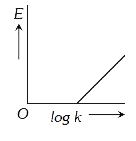EMF of a cell is related to standard EMF,E∘ by the equation
E=E∘−0.0591nlogk
Where k is reaction quotient and n the volume of electrons which is correct graphical representation




The correct Answer is:B
Properties of ionic solid
Similar Questions
The standard electrode potentials at 298 K are given below:
E0Zn2+∣Zn = -0.76 volt and ,E0Fe2+∣Fe = -0.44 volt ,E0H2+∣H2 = -0.0volt
Which of the two electrodes should be combined to form a cell having highest EMF? Identify the cathode and the anode and write the cell reaction. Also mention the direction of flow of electrons in the external as well as the internal circuit.
View SolutionThe standard electrode potentials at 298 K are given below:
E0Zn2+∣Zn = -0.76 volt and ,E0Fe2+∣Fe = -0.44 volt ,E0H2+∣H2 = -0.0volt
Which of the two electrodes should be combined to form a cell having highest EMF? Identify the cathode and the anode and write the cell reaction. Also mention the direction of flow of electrons in the external as well as the internal circuit.
View Solution
Knowledge Check
Assertion: The emf of a cell is related with equilibrium constant of the cell reaction as Ecell=0.0591nlog K.
Reason: As Ecell changes with concentration of the electrodes, K of cell reaction also changes with concentration.AIf both assertion and reason are true, and reason is the true explanation of the assertionBif both assertion and reason are true, but reason is not the true explanation of the assertion.Cif assertion is true, but reason is false.DIf both assertion and reason are false.The cell potential (Ecell) of a reaction is related as △G=−nFEcell, where △G represents max. useful electrical work
n=no. of moles of electrons exchanged during the section
for reversible cell reaction d(△G)=(△rV)dp−(△rS),dT
at constant pressure d(△G)=−(△rS).dT
:' At constant pressure △G=△H−T.△S
:. /_\G=/+\H+T(d(/_\G))/((dT)_P)<br>((dE_(cell))/(dT))_Pisknownastemperturecoefficientofthee.m.fofthecell.<br>Thetemperaturecoefficientofthee.m.fofcell,((dE)/(dT))_P si given by:AnF△SB△SnFC△SnFTD#REF!In an electrochemical cell, if E∘ is the e.m.f. of the cell involving 'n' mole of electrons, then ΔG∘ is
AΔG∘=nFE∘BΔG∘=−nFE∘CE∘=nFΔE∘DΔG=nF/E∘
A group of N cells whose emf varies directly with the internal resistance as per the equation EN=1.5rN are connected as shown in the figure. The current in the circuit is

View SolutionThe standard electrode potentials at 298 K are given below:
E0Zn2+∣Zn = -0.76 volt and ,E0Fe2+∣Fe = -0.44 volt ,E0H2+∣H2 = -0.0volt
Which of the two electrodes should be combined to form a cell having highest EMF? Identify the cathode and the anode and write the cell reaction. Also mention the direction of flow of electrons in the external as well as the internal circuit.
View Solution
A group of N cells where e.m.f. varies directly with the internal resistance as per the equation EN=1.5rN are connected as shown in the figure. The current I in the circuit is:
View SolutionThe driving force ΔG diminishes to zero on the way to equilibrium, just as in any other spontaneous process. Both ΔG and the corresponding cell potential (E=−ΔGnF) are zero when the redox reaction comes to equilibrium. The Nernst equation for the redox process of the cell may be given as :
E=E∘−0.059nlogQ
The key to the relationship is the standard cell potential E∘, derived from the standard free energy changes as :
E∘=−ΔG∘nF
At equilibrium, the Nernst equation is given as :
E∘=0.059nlogK
The equilibrium constant Kc for the reaction :
Cu(s)+2Ag+(aq.)+2Ag(s) (E∘cell=0.46V) will be :
View SolutionThe driving force ΔG diminishes to zero on the way to equilibrium, just as in any other spontaneous process. Both ΔG and the corresponding cell potential (E=−ΔGnF) are zero when the redox reaction comes to equilibrium. The Nernst equation for the redox process of the cell may be given as :
E=E∘−0.059nlogQ
The key to the relationship is the standard cell potential E∘, derived from the standard free energy changes as :
E∘=−ΔG∘nF
At equilibrium, the Nernst equation is given as :
E∘=0.059nlogK
The nature of graph of E∘cell against logKc is a/an :
View Solution
